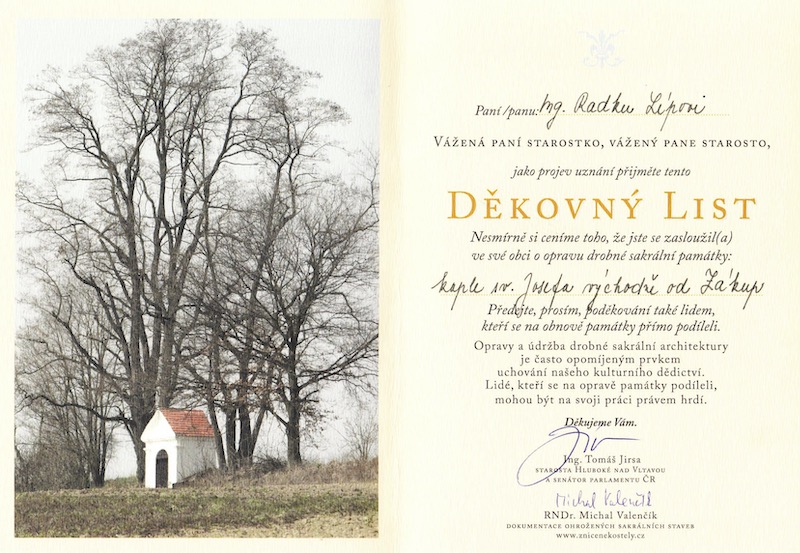
The St. Joseph chapel in Zákupy was built in 1698 by Gian Gastone de' Medici and his wife, Anna Maria Franziska of Saxe-Lauenburg. Gian Gastone was the seventh and last Medicean Grand Duke of Tuscany. She came from one of the most significant noble families of the Baroque period, and was renowned for her modern, often very expensive renovations of her dwellings.
We discovered the Chapel Of St. Joseph in 2012, after it had been on the market for several years. It immediately charmed us as a piece of Tuscany transplanted to the northern Czech Republic. We started to research its history and found out it was built by the Medicis from Florence, when they owned the local chateau in the late 17th century.
Having been looking in Europe for a suitable 18th century Baroque or Greek-Revival building to renovate, we immediately became attracted to it. By 2012, we had looked at houses in small towns in southern France, Spain and Italy, which definitely fulfilled the charm requirement, but a suitable renovation seemed too expensive. We had also looked at a number of small castles, country manors, rectories, even a church in the Czech Republic. These were more in line with our intended budget, but most suffered from various problems, which were inflicted by 40 years of Communism: a pig farm built adjacent to a chateau expropriated in the Communist revolution in 1948, a formal garden chopped away from a country manor to make a potato field, or just such disrepair that a renovation did not seem doable anymore.
In contrast, the St. Joseph chapel in Zákupy stood out: decent shape, beautiful piece of land with a view of a valley, line of sight with the imperial castle to the west, plus a variety of other buildings around the property, including a cave! Having previously rebuilt a church in the New Orleans area into a home, we were ready. We knew this was it!
Here are a few pictures showing the property just as we found it in the fall of 2012 (see "Picture Galleries" for larger versions):

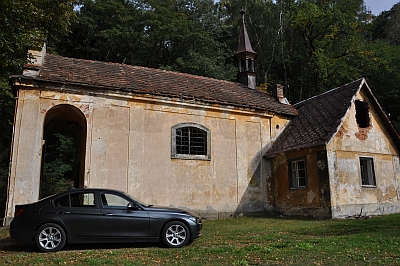
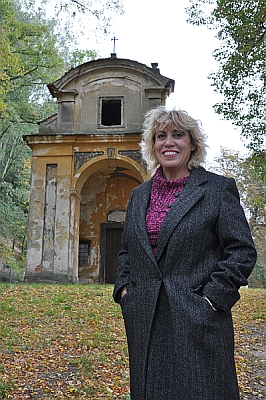

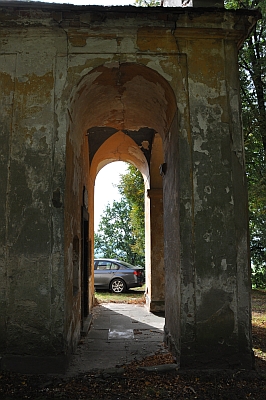
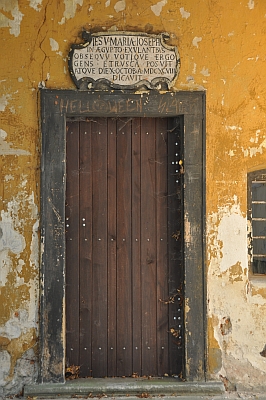
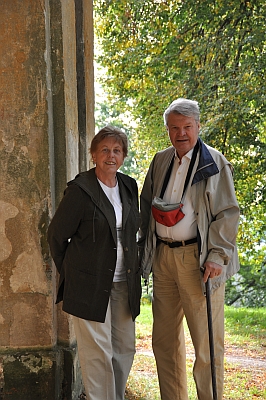
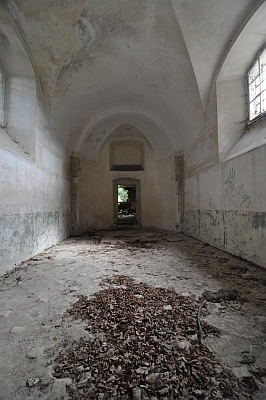

17th Century

Gian Gastone de' Medici was born in Florence in May 1671. His birthplace was the Palazzo Pitti, a posh 32,000-square-meter (344,000 sq ft) residence on the south side of the Arno River near the Ponte Vecchio, which had been the the principal residence of the Medici family since 1549. Just to mention, the Medicis ruled the Grand Duchy of Tuscany from it for several centuries, amassed a huge collection of paintings, plates, jewelry and luxurious possessions, and were one of the richest and most influential families of Renaissance and Baroque Europe. Finding a piece of their real estate abandoned and neglected amounted to finding an Elvis Presley guitar in a pawn shop!
Concerned for the future of the Medici dynasty, Gian Gastone's father, Cosimo III de' Medici, urged Anna Maria Luisa de' Medici, Gian Gastone's sister, to find Gian Gastone a suitable wifey. She put forward Anna Maria Franziska, her brother-in-law's widow and heiress of the Duchy of Saxe-Lauenburg.
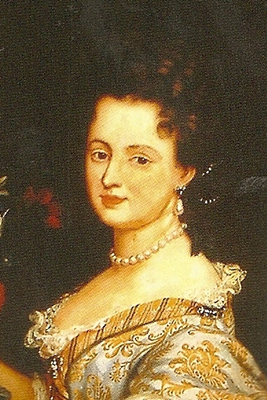
At first, his ownership of the Zákupy estate was plagued by invasions and revolts. The castle was invaded and burned several times. In 1634 and 1639, the castle was ransacked by Saxon and Swedish troops. Then came a peasant revolt in 1658. Despite all this, he nevertheless laid out the groundwork for a grand renovation of the Renaissance castle, and rebuilding it into a grand Baroque mansion.
When Julius Henry died in 1665 at age 79, the Zákupy estate was inherited by his son Julius Francis. It was him who ultimately kick-started the rebuilding. Julius Francis was born in Prague in 1641 and was the Duke of Saxe-Lauenburg between 1666 until his death in 1689. He had inherited his father's estates at Zákupy (Reichstadt), Ploskovice (Ploschkowitz) and Ostrov (Schlackenwerth), plus more estates from his Lobkowicz mother. He was wealthy, well-educated and worldly. Under his ownership, Zákupy Castle was being rebuilt into a grand early Baroque estate. Yet, it still consisted partly of Gothic, Renaissance and Baroque masonry, and its square four-winged layout still pointed to its origins as a medieval fort.
The architect in charge was Giovanni Domenico Orsi, an Italian by heritage but Viennese-born. He built a number of very prominent religious and civic buildings the Czech Kingdom, such as the Jesuit College in Kutná Hora, or the Kolowrat Palace and the Church of St. Havel in the Old Town in Prague. His style was grandiose, fit for Viennese palaces.
In Zakupy, in addition to the main four-winged castle itself, a farmstead, brewery and gardens were built under Julius Francis. In the town, on the opposite bank the Svitávka River, Julius Francis built the Capuchin monastery between 1681-1683 as a way of giving thanks for his survival in a battle with the Turks. The geometric relationship of the monastery to the castle can be seen in the context of secular vs. religious powers, in that the front of the monastery was placed in a manner to face the most monumental side of the castle. This baroque axial composition was later further extended by the construction of our chapel.
However, having no male descendants, upon the death of Julius Francis in 1689, the family became extinct in the male line. The Lauenburg estate was fought over by numerous sides, including his two daughters and his cousin. George William, Duke of Brunswick-Lüneburg, invaded Saxe-Lauenburg with his troops, thus inhibiting the ascension of the legal heiress. Other monarchies claimed the succession: the neighboring duchies of Mecklenburg-Schwerin and of Danish Holstein, as well as five principalities of Anhalt, the Electorate of Saxony, and even Sweden and Brandenburg. In 1728, Charles VI finally legitimized the takeover. Anna Maria Franziska and her sister Sibylle, never having waived their claim, were dispossessed of Saxe-Lauenburg. Anna Maria Franziska was exiled in Ploskovice and Zákupy. This is how she eneded up relocating full-time to the Czech Kingdom.
However, in the long term Anna Maria Franziska did all right. In her life she amassed an astonishing estate, nicknamed the "Tuscan Estate", consisting of her father's Czech assets including Zákupy as well as other estates acquired on her own. She was married, had two daughters, but her first husband Philipp Wilhelm of Neuburg died young in 1693. Enter Gian Gastone de' Medici and the politically arranged marriage between the two families. They were married in Düsseldorf on July 2, 1697. Anna Maria Franziska demanded that they reside in her Czech residences, Ploskovice and Zákupy. Being a country girl, she did not like cities or courts, but liked horses and was being described as a Czech peasant rather than a princess. On the other hand, Gian Gastone came from Florence, the centerpoint of Renaissance culture. He was born into one of the wealthiest and most influential families of the Western world at the time, who had ruled Florence for almost 300 years. It does not come as a surprise that he found life in the small town of Zákupy boring as hell. Although he imported his court and servants from Italy, things were still a far cry for him life the Palazzo Pitti in Florence.
It was in 1698 that our Chapel of St. Joseph was built. It was a pet project of the members of Gian Gastone's court, who financed it themselves. They hired Giulio Broggio, the court architect who was in charge of the rebuilding of Zákupy Castle at that time, and thought it would be nice to build a chapel on the hill rising above the Capuchin monastery to the east. Giulio Broggio had been in charge of the rebuilding of Zákupy Castle since 1689, following the death in 1679 of his predecessor, Giovanni Domenico Orsi. Broggio was given a sack-full of money and asked to please build us a Tuscan-looking chapel right under the edge of the woods over there; we don't care how much it costs.
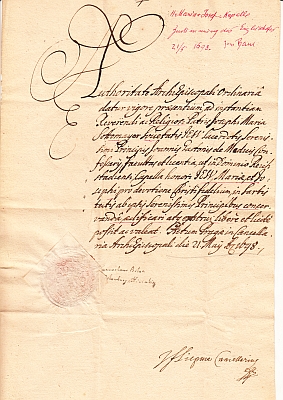
The building permit says:
"The Archbishopric of Prague, at the request of Jesuit P. Joseph Maria Sotomayer, personal confessor of Grand Duke Gian Gastone de Medici, hereby grants the permission to build in Zákupy a chapel dedicated to Jesus, Maria and Joseph. In Prague, Office of the Archbishop, on May 21, 1698."
The chapel was designed with a massive front portico, with a facade and vaulted ceiling looking like a small piece of Florence transplanted to Central Europe. Fairly plain, yet unmistakably Italian in appearance. Inside, the chapel consisted of one nave with 5-meter (15-ft) vaulted ceiling, 5 windows and a door on each end. The facade above the portico was borrowed from the entry way of the castle:

The inscription above the entrance to the chaple reads:
"IESV MARIA IOSEPH
IN AEGYPTO EXULATIBUS
OBSEQVY VOTIQUE ERGO GENS ETRUSCA POSVIT
ATQUE DIEX OCTOB A MDCXCVIII
DICAVIT"
(To Jesus, Maria, Joseph, exiled in Egypt,
dedicated by the Etruscans being observant of their pledge, on October 10, 1698.)
The chapel was built in mere four months and consecrated on October 10, 1698.
The consecration order says:
"The Archbishopric of Prague, at the request of Gastone, Grand Duke Of Tuscany, hereby grants the permission to Jezuit P. Joseph Maria Sotomayer, the confessor of said Grand Duke, to consecrate the chapel to honor Jesus, Maria and Joseph."
-- Signed by the Office of the Archbishop, on October 10, 1698.
There is a hand-written note below the text, added by Sotomayer himself, confirming that he personally consecrated the chapel on October 10, 1698:


Giulio Broggio, the architect, was born in the small town of Albiolo near Lake Como in northern Italy. His entire family migrated to the Czech Kingdom and settled in the town of Litoměřice. Giulio learned to be a carpenter and rose from a trainee in 1658 to a notable builder who built many important Baroque buildings, including castles, churches and luxurious touwnhouses. He became the official court architect for the Saxe-Lauenburg family in 1689. He initially continued in implementing Orsi's designs, but gradually moved toward designs of his own (eg. bridge over the moat and outbuildings in front of the castle). Their distinctive styles are very apparent in the Zákupy castle. Orsi's style was more grandiose and elaborate compared to Broggio's, whose buildings are simpler and typical of the "Czech" baroque (simple windows, onion-shaped church towers etc). The castle itself, being designed and mainly built by Orsi has grand windows and gates, while the outbuildings around the castle designed and built by Broggio are plain in comparison.
Broggio worked on the Zákupy Castle project until 1700, upon which time he began to transfer his business to his son Octavian. Octavian Broggio carried out extensive construction works on the castle gardens between 1700 and 1701. Giulio Broggio's official successor as court architect was Jan Jindřich Klingenleitner from Prague. However, his involvement lasted only until 1703. He received a low salary illustrating the overall waning of construction activities.
Anna Maria Franziska devoted most of her life to the building, expansion and beautification of her numerous chateaus. She bought and built new chateaus, churches, rectories, and even in 1718 a grand palace in Prague built by count Thun-Hohenstein, known today as the "Tuscan Palace" opposite to the entrance to the Prague Castle. She was also known for her benevolent relationship to her subjects: farmers, foresters and other people responsible for the upkeep of her assets. Altogether, she lived in Zakupy for 52 years.
However, her marriage to Gian Gastone was not a happy one. He did not like her and did not care for Zákupy. He ultimately stayed with his wife for a mere ten months, before escaping to Paris. His father Cosimo explicitly told him not to leave Anna Maria Franziska and ordered him back to Zákupy to give him a male heir. Anna Maria Franziska made an effort to welcome him back; however, her mood turned sour when Gian Gastone brought up the prospect of moving to Prague. He ultimately left for Prague with his favorite servant Giuliano Dami. While in Prague, Gian Gastone pursued the good life: drinking, eating, partying and gambling. He racked up exorbitant gambling debts, and owed the most to the Archbishop of Prague! His father had to dispatch a carriage loaded with gold to pay off his son's gambling debts to the Archbishop.
Gian Gastone wanted to live in Prague or Florence, but Anna-Maria would have none of it. Gian Gastone did return to Zákupy as per the Holy Roman Emperor and Holy Roman Empress's advice. Nevertheless, their reconciliation was brief, and Gian Gastone left for Hamburg in October 1703, only to return to Prague the next February. Gian Gastone requisitioned the help of Pope Clement XI, who sent the Archbishop of Prague a letter to tell Anna Maria she had to move to Florence with Gian Gastone. Gian Gastone's father appealed to her to fulfil her marital duties and bear them a child. She was incensed, replying that there was no point going with him because he was "absolutely impotent". However, erectile disfunction was not the problem; sexual orientation was. Gian Gastone's family finally conceded defeat and recalled Gian Gastone to Florence in 1708. He never saw his wife again and this is how the Medici family became extinct in the male line. One of the most powerful families in the world became extinct because of what happened, or did not happen, in Zakupy....
Anna Maria Franziska is described by some historians as "appalling and immensely fat", or as "a domineering person who drove her weak husband into the arms of alcohol". Others viewed heras a remarkable woman who not only succeeded within the largely male-dominated 18th century society, but succeeded in building a remarkable empire and stood out one of the most significant noblewomen of the European Baroque period. We think Gian-Gastone probably did not need much encouragement to hit the bottle. He led a party-goer's life in Prague. His wifey, on the other hand, was extremely smart. Being still married to him, she built a very cute Rococo chateau in Ploskovice using her husband's money. Upon completion, she burned all the invoices and records, so that Gian Gastone could not find out how much it cost him. She saw how much hubby was spending on gambling, so she thought "You are wasting bundles of money playing cards, I will build me a castle...". Good for her! However, the bottom line is, nobody knows who the architect or builder was. At the same time, given the Medicis' deep pockets, Gian-Gastone probably would not have cared how much it cost anyway.

18th Century
In 1727, an addition was built to the back on its eastern side. The builders were local workers, bricklayer Jan Adam Stampach and stone mason Jan Kryštof Strantz. The total budget was relatively meager: 53 gold pieces. This is documented in a paper by Macek and Zahradnik (1996). We have not found any floorplans or drawings, but apparently during this second building period a hermitage was built consisting of an attachment to the chapel, a cellar, cave and an animal pen.
The addition on the east side of the chapel appears on Austrian military land maps from the mid-1840s. On photographs taken in the early 20th century, the annex was called the "Jägerhaus" (Hunters' House) and appeared more like a tavern than part of a church. It was built of brick and was not constructed nearly as robust as the chapel itself. In 2015, the walls of the Jägerhaus were in such a poor shape that they had to be torn down. Our 2015 renovation rebuilt the rear annex on basically the same floorplan, but with 21st century building materials and technologies.
Sometime in the 18th or 19th centuries, other structures were built around the property. These included a two-storey wooden restaurant called the "Schützenhaus" (Riflemens' House) in the eastern corner of the property. The Schützenhaus survived Hitler but unfortunately did not survived the Communists, and burned down or was burned down in sometime in the 1950s.
A calvary was built by Anna Maria on the hill immediately above the chapel. It consisted on a large cross at the top of the hill, two small chapels below it, and footpaths with stations of the cross. These were unfortunately destroyed during Communism, and only remnants of walls remain. The annex to the chapel and the Calvary are clearly seen on this 1840s map:
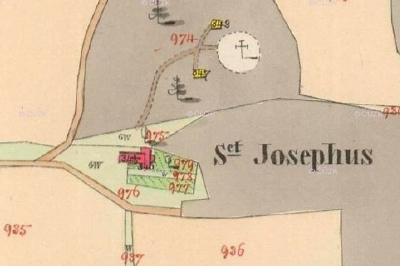

19th & 20th Centuries
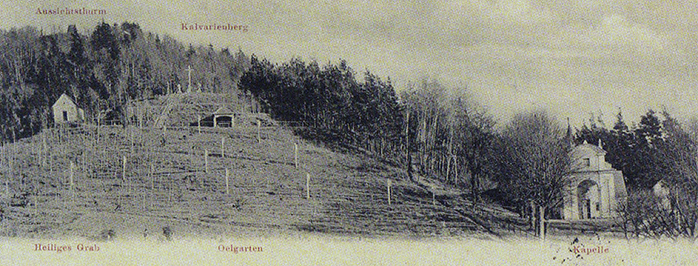
The chapel and its surroundings always belonged to the Zákupy castle. Until 1918 the whole estate belonged to the Austrian imperial family, the Habsburgs. When the Habsburg Empire disintegrated in 1918 at the end of World War I, the whole estate became property of the newly formed Czechoslovak Republic. The castle is still state property, but the chapel was sold off in 2005.
Here are pictures of the complex from the first half of the 20th century:
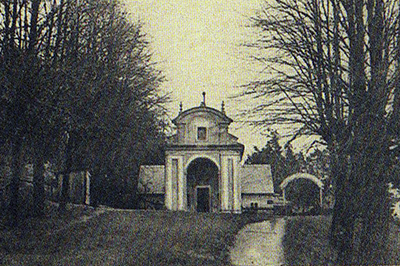


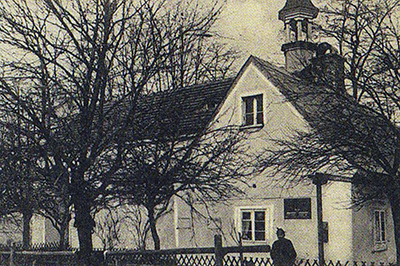

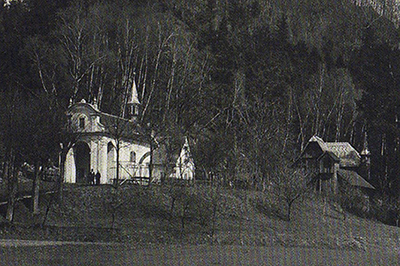
At the end of World War II, it was the Soviet Army that took posession of this part of Europe. It cannot be called "liberation" simply because an army of one ruthless dictator (Stalin) replaced the army of another ruthless dictator (Hitler). Iin Czechoslovakia, this prepared a fertile ground for the Communist revolution and coup d-etat, which took place 3 years later in 1948. 40 years of tyranny and destruction followed.
The Communist armed militia came to the chapel sometime around 1952, stole the entire contents of the chapel and took it God knows where (pers. comm. Mr. Stahl). The wooden restaurant "Schützenhaus" burned down or was burned down.
Thankfully, the local hunting club managed to get a lease on the building and preserved it. The maintenance and repairs they did over the years saved the chapel and the other buildings.

21st Century
Fast-forward to 2014. We purchased the property and started a large-scale renovation and rebuilding in 2015. A local very creative construction company was hired to do the work. The chapel has retained its original look but the rear annex was built and a patio with a fountain and ballustrades was added to the front: this time, with a proper budget, and following the Baroque style we think Broggio would have used had he built it all at the same time. The new rear annex is based on the style of the front buildings of the Zákupy chateau, which were designed and built by Broggio.
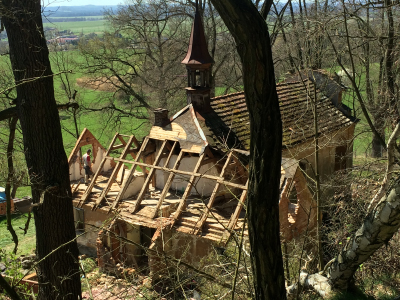
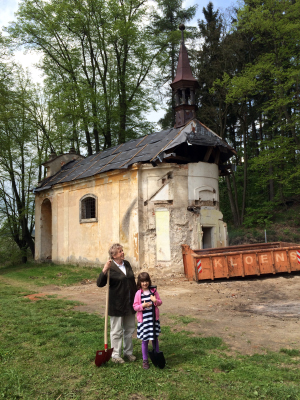
When we tore down the existing annex, we found a cellar with vaulted ceiling. The entrance to the cellar was covered over by one of the walls of the annex, indicating the cellar was older and the annex younger. The cellar was probably part of the hermitage built in 1727.
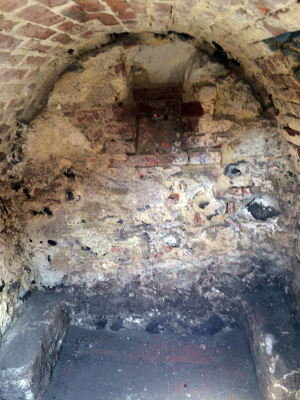
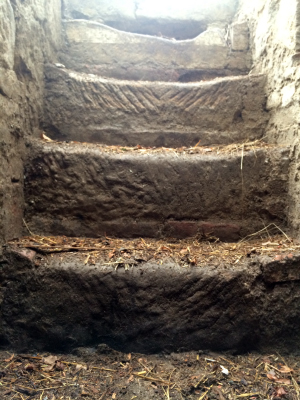
During our renovation in 2015-2018, we found clear evidence on the rear walls of the chapel that an older rear addition had once been built onto the back of the chapel, pre-dating the addition from 1845. The appearance of the older addition is unknown; we have not found any floorplans or drawings. But it was most likely built in 1727 as part of the hermitage. Macek and Zahradnik (1996) document invoices showing that construction was taking place:
Builder Jan Adam Stampach from Zakupy was hired to build it for 35 gold pieces, and stone mason Jan Krystof Strantz was paid 18 gold pieces for 5 doors and 6 windows.
We believe that the other small stone structures on the property (the animal pen behind the chapel, the cave and the small stone house next to it, and the cellar) were all part of this 1727 construction project.
We found clear evidence that another rebuilding of the chapel complex took place in 1845. This has not been previously undocumented in literature. We found numbers "1845" and a carpenter's name carved into one of the roof rafters. We believe that it was at this time that the newer annex was built.
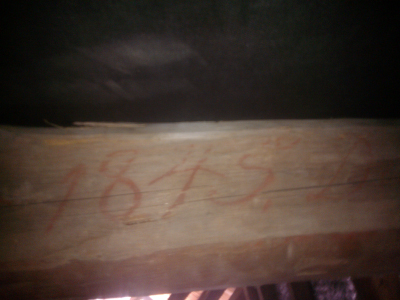

In conclusion, there have been four stages of construction at this site:
- Broggio's chapel in 1698
- Addition of the hermitage in 1727 (including an older rear addition to the chapel)
- The building of a newer rear addition and installation of a new roof in 1845
- Our complete renovation in 2015-2018.

Fast-forward to 2018. The renovation of the St. Joseph Chapel and the rebuilding of the rear section has been finished! The chapel and the former simple and poorly built Jägerhaus are now a mansion that can be comfortably lived in. The whole complex preserves all the 18-19th century history that could be preserved, while adding all the amenities of the 21st century: in-floor heat, air-conditioning, broadband Internet, smart-home technologies, and first and foremost an great audio system in the chapel that for the first time in 300 years allows Bach and Vivaldi to be played at these premises in ways these walls have never dreamed of!)
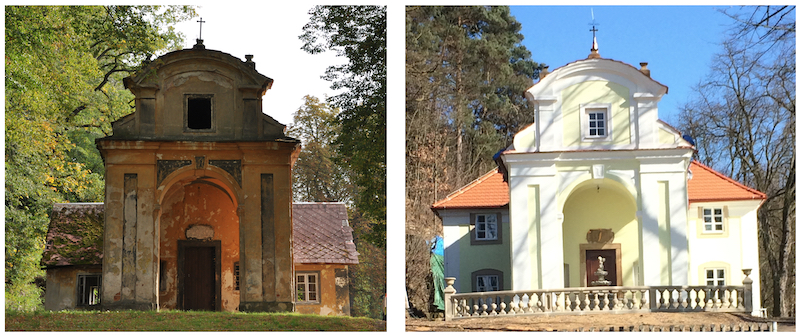
How has the community reacted to our taking a local landmark and converting it to a residence?
Positively!
